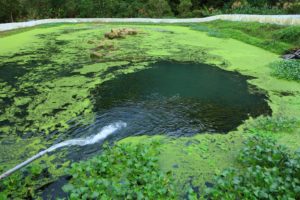Algae are small primitive plants that bear close resemblance to fungi. Pond algae are a normal part of a healthy environment, but they can grow excessively. These plants are commonly seen floating on the surface of a pond.
Unlike most plants, Algae doesn’t have roots or leaves. They often absorb nutrients from elements in the water where they float. Just like most plants, algae utilize sunlight to grow.
There are many kinds of algae, like green, red, brown, and blue-green algae. It’s important to be familiar with them because most are harmless, but some blue-green algae (Lyngbya) can produce potent toxins. These toxins are produced inside the cells and stay there as long as the cells are alive. When cells die and break down, toxins can be released into the water. If animals drink from algae-infested water, they can ingest the toxins, which poison and possibly kill them.
There are more than 17,300 algae species that have been discovered and possibly thousands more yet to be discovered.
What are the types of pond algae?
There are 6 different types of pond algae.
- Planktonic Algae
- Filamentus Algae
- Lyngbya
- Pithopora
- Algae Diatoms
- String Algae
Planktonic algae
Planktonic algae are small microscopic plants, which tend to thrive on the surface of the water. This plant often changes the color of water. From pea soup to brown or green. Planktonic algae can regulate the oxygen within your pond, hence if they die off, the fish might die too due to lack of sufficient oxygen. Some planktonic algae species are toxic to humans, livestock or wildlife. Other species can create an odor or change the taste of the water in the pond.
Filamentus algae
Filamentus algae, commonly known as pond moss or pond scum are a type of pond algae that thrives on the surface of the water and replaces the natural color of the water with green mat-like plants. This plant often grows at the bottom of the pond, and as it ages, rises to the surface. The individual pieces of filamentus algae are a thread-like series of connected cells.
Lyngbya (resistant algae)
Lyngbya algae is a type of blue green pond algae. Just like filamentus algae, this plant begins to develop on the bottom surface of the pond and then grows toward the surface. When it reaches the surface of the pond, it can appear blue green, black or grey. It turns to sponge-like colonies, shielded by mucilage. Since mucilage is highly resistant to chemicals, Lyngbya is very difficult to remove from the ponds.
Pithopora (resistant algae)
Pithopora, also commonly known as horsehair pond algae, is a dark green algae. This type of pond algae often grows in wide clumps that bear close resemblance to steel wool. The individual filaments consist of widespread branches. Pithopora algae have rapidly regenerating cells which make them grow more quickly. It also starts to develop at the bottom surface of the pond and ultimately grows up to the surface.
Algae diatoms
The cell walls of this type of pond algae consist of silica, a mineral substance. Diatoms are brown or grey in color and typically grow in colonies. Unlike other types of pond algae that float in water, algae diatoms develop on solid surfaces.
String algae
String algae is a type of pond algae that grows in water bodies bordering other plants or rocks. They normally appear as long green hair. Although string algae are not hazardous, they can ruin the natural appearance of the water in the pond.
Click here to find out about aerating water so you can maintain a healthy pond environment.

